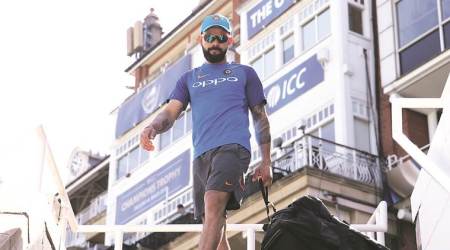 Yusuf and Farida Hamied Foundation will sponsor Amir’s expenses for a year. Pradip Das
Yusuf and Farida Hamied Foundation will sponsor Amir’s expenses for a year. Pradip Das
IT WAS the way he arched his feet that sealed Amiruddin Shah’s fate. That perfect arch, important to ballet, was how the 15-year-old was introduced to a dance form that he’d never heard about earlier. Now, nearly three years after having chanced upon the dance form, the teenager, a welder’s son, is finding it to be a key opening up many firsts in his life, the most prominent being the chance to attend the American Ballet Theatre’s Jacqueline Kennedy Onassis School in New York. After some setbacks and concerns about costs, Amir’s dreams are now set to come true with the Yusuf And Farida Hamied Foundation agreeing to sponsor his expenses for a year starting September.
As he wraps up dance practice for the day at Danceworx Academy in Andheri, Amir, dressed in a t-shirt with cutaway sleeves and shorts, is sweating profusely. Even with his athletic, lean figure, once he’s out of his leotards and ballet shoes, Amir is transformed from a ballet dancer to a regular teenager. Sitting in one of the rooms at Danceworx, he watches with mischievous eyes but takes a while to open up. Like many teens growing up in Mumbai, he was first drawn to hip-hop as a dance form, its counter-culture themes appealing to him.
With four brothers and two sisters, Amir is the youngest. Rather reserved about his family life, the boy says his eldest brother, Nizamuddin, who was interested in jazz, was his inspiration to become a dancer.
Nizamuddin now runs a street dance production, while Amir’s second brother Shahbuddin is a rifle shooter and the other one runs a xerox shop. Amir’s fourth brother is specially-abled. “My father is a welder and mother is a housewife,” Amit says adding that he is closest to his mother. In 2014, at a dance workshop organised by his brother’s team, the audience had been asked if they could perform cartwheels and backflips and Amir happened to be able to do both.
That’s when his dance journey began with a scholarship from Ashley Lobo’s Danceworx that is given to young talent from a poor background. “I didn’t know what ballet was three years ago. But while I was doing contemporary and jazz, attending ballet was compulsory for us. I had no interest since you had to wear girls’ clothes. I really resisted going for the classes. Then at one ballet class, international ballet master Yehuda Maor saw my feet arch during warm-up and he knew that I would be a ballet dancer,” recounts Amir.
He will be leaving for New York with Maor, he adds. Maor (73) says he spotted Amir when the boy was taking a class in the hope of getting a scholarship.
“While seeing him dance, I knew I had hit a jackpot. I have years of experience and can recognise natural talent,” he said. In 2013, Amir was in Wadala, in central Mumbai, and attending a government school where he studied till Class IX. “I was not interested in ballet. Maor sir used to shout at me. I would cry after every class,” says Amir.
Coming from a working-class family and with poor English skills it was a struggle. “I didn’t understand English. People had to translate what sir told me, after classes. I don’t know when I suddenly developed an interest in ballet and it became fun for me,” says Amir emphasising that his parents have been very supportive throughout.
His growing passion for ballet has meant a life-change. “Earlier, I was just like any other boy but I don’t feel that way now. I don’t have any friend. I don’t go out playing or hang out with others,” says Amir.
He spends time with other children in his class, concentrates on improving his technique and motivates himself to improve his jumps and turns. “My inspiration and ideal is Daniil Simkin, a Russian ballet dancer and principal dancer with the American Ballet Theatre. I want to be a principal dancer like him,” he says when asked about his ambition in life.
A principal dancer is the highest ranking performer in a professional dance company.
Ballet class starts at 9 am in Andheri and Amir tries to arrive by 8 am so that he has ample time for warm-up. “For this, I have to start from my home at 5 am,” says Amir. After the class at Danceworx, he heads to a private tuition arranged with Maor so that he is better prepared for his US stint.
Earlier this year, he attended the School of Oregon Ballet Theatre but says he could not settle there and returned in the middle of training. Maor says Amir has been invited to study at the Joffrey Ballet School in NYC and Oregon Ballet Theatre School. “In Oregon, he was living with a doctor and his family. He sat on a plane for the first time and saw snow for the first time but eventually, he couldn’t settle in and we brought him back in four weeks.” This time, the preparation includes English classes and other lessons.
“I have arranged for a private tutor for him and he is tutored, mainly in English, at my house,” Maor says. Amir needs approximately over USD 20,000 for a year’s stay in NYC.
Maor, who is Isreali-American, was in Delhi before this.
Classical ballet has completely skipped India, he rues, adding that Indian children, with their lean build, could in fact be ideal ballet students. Amir has given him and his work in India new meaning, says Maor. “I was done with my stay in India before Amir stepped in. He gave a new direction to my life. I have been training him for over two years,” he says.
Maor has been impressed with the boy’s dedication and improvement. “Even after class, he stays back and works for six to seven hours a day.” To save the three hours of one-way commuting from his home in Sanpada, Amir sometimes stays with friends in Andheri. He loves chicken, the way his mum cooks it, and jalebis and rasgullas are his favourite sweets. “I need to focus on my diet but I work out and it’s fine,” he says mischievously.
Before class, Maor, Amir and his tutor were caught relaxing in a coffee shop in Bandra. Asked why he doesn’t hang out with children his age, Amir said: “They don’t get me. I need to concentrate on ballet. It can change my life.”

